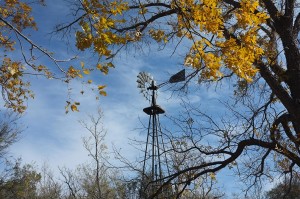Homer Wilson Blue Creek Ranch
Distance: 0.5 mile roundtrip
Hiking time: 30 minutes
Highlights: Partly restored ranch house and grounds
Difficulty: ★★☆☆☆
A short trail with a moderately steep climb down at the start (and back at the end)
Trail conditions: ★★★☆☆
Easy, other than figuring out where to cross the wash to house
Scenery: ★★★☆☆
The house sits in a desert valley with peaks looming in the “backyard”
Solitude: ★★☆☆☆
Crowded at times, but not steadily so
Sam Nail Ranch
Distance: 0.5 mile loop
Hiking time: 30 minutes
Highlights: Home ruins, working windmill and a lush oasis in the desert
Difficulty: ★☆☆☆☆
A short, flat walk
Trail conditions: ★★★★☆
Simple dirt trail with some shade
Scenery: ★★★☆☆
The water from the windmill supports lush vegetation in the middle of the Chihuahuan desert
Solitude: ★★☆☆☆
Just off the main road, it gets crowded at times
These trails visit two homesteads just off Ross Maxwell Scenic Drive – Homer Wilson Blue Creek Ranch and Sam Nail Ranch.
The Homer Wilson Blue Creek Ranch trail climbs down the hill from the highway and crosses a dry wash to a complex that includes a house, storeroom, corral and other facilities. The house is in relatively good shape, with wood-framed windows, a flagstone floor, cane ceiling and fireplace. The framed back porch looks out on the mountains.
Homer Wilson’s ranching operation was among the largest in the Big Bend Area, covering 44 sections of land. While the ranch’s headquarters was at Oak Canyon, most of the activity was at Blue Creek. The historic property’s National Register form describes the construction of the home:
Practically all of the materials for the construction of the house came from the area. The stone, sand, and gravel came from Blue Creek Canyon, the timber from the Chisos Mountains, and the reed from the nearby Rio Grande. Thus the Blue Creek line camp ranch house may be said to be indigenous to the area.
The Sam Nail Ranch Trail is a short loop that circles a mud-brick wall – all that remains of the original homestead. What is striking about the location, though, is the lush vegetation – walnut and pecan trees, shrubs and flowers – that creates a small oasis in the desert. The foliage, visiting birds and other wildlife benefit from an underground stream that runs along the wash and a windmill that pipes water to the surface. The working windmill is just a short distance from the ruins of an older one.
An article from the Fayette County Historical Commission describes the property as it stood in 1918, when Sam Nail brought his wife, Nena Burnam, there:
Their home was nestled among willow and pecan trees at the foot of Burro Mesa. There was a shaded patio of flagstones at the back of the house and flowerbeds around a hand-dug well lined with rocks that was located on Cottonwood Creek. A wind mill and concrete water storage tank, that was also a “swimming pool” for many of their family members and friends, was located nearby. The interior of the house had white-washed walls with pine beams and sotol poles for the ceiling, which helped keep the house cool in the heat of the summer.

